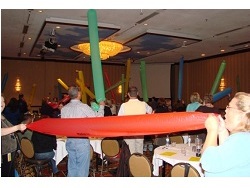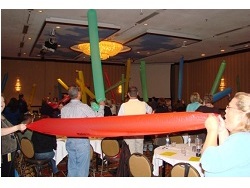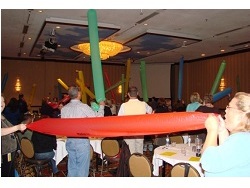


The closing ceremony of each Olympics is an example of a great closing—music, dancing, fireworks, inspiring words, celebration. However, the closing part of business presentations seems to be the most difficult to executive in an effective way, in our opinion based on many collective decades of training.
Have you ever tried using a closing exercise to tie your presentation together, to inspire your participants to use what they’ve learned? We recommend using STAR to create an effective closing:
Summarize,
Tie things together,
Apply the new learning, and
wRap up with power!
Below is one exercise, from our book SCORE, that can help you close with impact while creating momentum for your learners to implement what they’ve learned.
Purpose: This exercise overcomes potential barriers to retention and application. It identifies ways to overcome the hidden and obvious hurdles that often get in the way when participants attempt to use
new content or change behavior after a seminar.
Audience: Any size
Time: 5–10 minutes
Space: Any classroom
Materials: Two flip charts and markers
Budget: Minimal
Application: Have participants identify obstacles or barriers that may get in the way of using new materials or content on the job. They then brainstorm ways to overcome those barriers to ensure a greater amount of transfer of training and application of new content/skills.
Process: Toward the end of your training session, ask this startling question,“What can you do to make sure that you won’t apply anything you have learned in this class – or make any changes to your current
behavior?”
After people get over the initial surprise of your question, explain that you really want them to brainstorm all the barriers or obstacles they will face as they attempt to use new skills or try out different behaviors as a result of this class. Further explain that we all know that change can be difficult, so let’s face it now and then determine what we’ll do to overcome those hurdles so we’ll be prepared to “fight the gremlins.”
Tell the group that once they’ve come up with a list of obstacles, they’ll then create a list of what can be done to prevent those obstacles from getting in the way.
This will be an all-class activity as individuals will just contribute ideas as a part of the large group.
Ask for two volunteers to be your scribes at the flip charts. (If you only have one flip chart, tear off several sheets of chart paper and tape them to the wall.) The scribes will alternately write the learning
obstacles on the sheets as participants call them out. This will be a light-hearted exercise as participants usually have fun coming up with the gremlins to learning. Allow three to five minutes for participants
to share ideas, and stop the activity as soon as the ideas stop.
You will likely get ideas such as:
a. My learning manual gets put away on the shelf.
b. I won’t have time to implement any new ideas.
c. I’ll try to change everything at once.
d. My manager won’t support my new learning.
After the first round of brainstorming stops, ask for two new volunteers to come up to the flip charts as scribes. Using new sheets of paper, take the barriers one by one and ask participants what are some things they can do to keep these obstacles from getting in the way. Have scribes capture these ideas on new sheets of paper.
Examples might be:
a. Keep my manual on my desk and refer to it often.
b. Set aside some time each day to consciously identify what new ideas or techniques I have implemented as a result of the class.
c. Start small; try one or two new ideas or techniques each day.
d. Let my manager know how important these ideas have been and how much his/her support will mean to me.
Cautions: Spend more time on overcoming the obstacles and less time on identifying them. You want participants to feel energized – not overwhelmed – by this activity.
Variations: Participants could write their barriers on Post-it® notes. Then have them take turns stating them aloud and posting them on a wall chart. Individuals could take turns coming up to the wall chart, pulling off a barrier and then stating a solution to overcome the barrier. Then crunch up the barrier Post-it note and throw it in the wastebasket.
Adapted from Super Closers, Openers, Reviews, Energizers for Enhanced Training Results by Rich Meiss and Doug McCallum. Used with permission.
Don't miss out on updates and chances
to sharpen your skills with participant-centered learning.




3740 N Chestnut St #113 - Chaska, MN 55318-3053